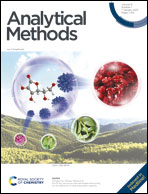A MALDI-MS-based impact assessment of ZnO nanoparticles, nanorods and quantum dots on the lipid profile of bacterial pathogens
Abstract
MALDI-MS was used for studying the impact of zinc oxide (ZnO) nanomaterials on Pseudomonas aeruginosa and Staphylococcus aureus. The growth patterns of both these bacterial pathogens in the presence of the ZnO nanomaterials and the subsequent lipidomic changes were assessed using an optimized simple, rapid MALDI-MS based methodology. All three nanostructures tested exhibited differential bactericidal activity unique to P. aeruginosa and S. aureus. The results indicated that the ZnO nanomaterials were highly inhibitory to S. aureus even at 70 mg L−1, while in the case of P. aeruginosa, the ZnO nanomaterials were compatible for up to 10 h and beyond 10 h only marginal growth inhibition was observed. The results proved that the shapes of the ZnO nanomaterials did not affect their toxicity properties. MALDI-MS was applied to study the lipidomic changes of P. aeruginosa and S. aureus after nanomaterial treatment, in order to throw light on the mechanism of growth inhibition. The results from the MALDI-MS studies showed that the ZnO nanostructures exhibited only marginal changes in the lipidomic profile both in the case of P. aeruginosa and S. aureus. These preliminary results indicate that the mechanism of growth inhibition by the ZnO nanomaterial is not through lipid-based interactions, but apparently more so via protein inhibitions.



 Please wait while we load your content...
Please wait while we load your content...